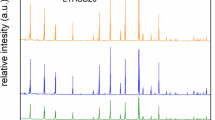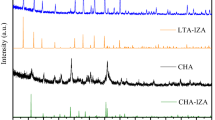Abstract
Three samples of pelletized zeolite Na-13X from different industrial suppliers were hydrothermally treated in an open system for up to 3500 adsorption/desorption cycles. Before and after this aging procedure, the samples have been characterized by water uptake measurements, X-ray powder diffraction (XRD), Hg-porosimetry, N2- and CO2-adsorption and small-angle X-ray scattering (SAXS). Large differences in the degree of degradation were found between the different materials: The adsorbent with the best performance maintains 79% of its original water uptake capacity after 3500 cycles, whereas this value is reduced to 65% after only 1600 cycles in case of the most unstable sample. For all materials, the residual water adsorption capacity was found to be higher than it was to expect from XRD data. In addition to structural changes of the zeolite cages, Hg-porosimetry and SAXS reveal a modification of the sample morphology in the meso- and macropore range. CO2 adsorption experiments evidence that as a result of the aging process mass transfer kinetics are slowed down significantly.
These findings indicate that the influence of hydrothermal treatment on the water adsorption performance not only depends on the crystal structure of the actual adsorbent, but is indeed a result of a complex interplay with the system of larger pores. The crucial role of the binder material is underlined by the fact that the most stable sample was produced by a so-called binder-free method.
Similar content being viewed by others
References
Buhl, J.C., et al.: Hydrothermal stability of the novel zeolite type LSX in comparison to the traditional 13X modification. Z. Anorg. Allg. Chem. 630(4), 604–608 (2004)
Close, D., Dunkle, R.: Adsorbent beds for energy-storage in drying of heating systems. Sol. Energy 19(3), 233–238 (1977)
Dimitrijevic, R., et al.: Hydrothermal stability of zeolites: Determination of extra-framework species of H–Y faujasite-type steamed zeolite. J. Phys. Chem. Solids 67(8), 1741–1748 (2006)
Ehrhardt, K., et al.: Hydrothermal decomposition of aluminosilicate zeolites and prediction of their long-term stability. Stud. Surf. Sci. Catal. 94, 179–186 (1995)
Fichtner-Schmittler, H., et al.: Hydrothermal damage of ion-exchanged a-type zeolite cation-directed mechanisms of phase-transformation. Zeolites 12(6), 750–755 (1992)
Gartler, G. et al.: Development of a high energy density sorption storage system. In: EuroSun 2004, Freiburg
Haubold, H.-G., et al.: JUSIFA—a new user-dedicated ASAXS beamline for materials science. Rev. Sci. Instrum. 60, 1943 (1989)
Hauer, A.: Beurteilung fester Adsorbentien in offenen Sorptionssystemen für energetische Anwendungen. Thesis, Technische Universität Berlin (2002a)
Hauer, A.: Thermal energy storage with zeolite for heating and cooling applications. In: R.Z. Wang (ed.) Proc. International Sorption Heat Pump Conference, Shanghai, 2002, pp. 385–390 (2002b)
Jänchen, J., et al.: Studies of water adsorption on zeolites and modified mesoporous materials for seasonal storage of solar heat. Sol. Energy 76, 339–344 (2004)
Keller, J.U., Staudt, R.: Gas Adsorption Equilibria. Springer, New York (2005), Chap. 1
Lutz, W., et al.: Investigation of the hydrothermal stabilities of NaA, NaCaA and NaMgA zeolites. Chem. Technol. 35(5), 250–253 (1983)
Lutz, W., et al.: Investigation of hydrothermal stability of synthesized zeolites of type NaCaA. Chem. Technol. 40(3), 121–125 (1988)
Lutz, W., et al.: Investigation and modeling of the hydrothermal stability of technically relevant zeolites. Adsorption 11(3–4), 405–413 (2005)
Mugele, J.: Optimierung von Speichermaterialien für den Einsatz in einem thermo-chemischenWärmespeicher für gebäudetechnische Anwendungen. Thesis, Technische Universität Berlin (2004)
Nuñez, T., Henning, H.-M., Mittelbach, W.: High energy density heat storage system—achievements and future work. In: Proc. ISES Solar World Congress 2003, Göteborg
Richtermendau, J., et al.: The pseudomorphous phase-transformation of faujasite-type zeolites in processes of their crystal destruction. Cryst. Res. Technol. 23(10–11), 1245–1252 (1988)
Stach, H.J. et al.: Influence of cycle temperatures on the thermochemical heat storage densities in the systems water/microporous and water/mesoporous adsorbents. Adsorption 11(3–4), 393–404 (2005)
Wolf, F., et al.: Über die thermische Stabilität von Molekularsieben des Typs A in Gegenwart von Wasserdampf. Chem. Technol. 2, 83–87 (1967)
Author information
Authors and Affiliations
Corresponding author
Rights and permissions
About this article
Cite this article
Storch, G., Reichenauer, G., Scheffler, F. et al. Hydrothermal stability of pelletized zeolite 13X for energy storage applications. Adsorption 14, 275–281 (2008). https://doi.org/10.1007/s10450-007-9092-7
Received:
Revised:
Accepted:
Published:
Issue Date:
DOI: https://doi.org/10.1007/s10450-007-9092-7




